Transfer Learning with Attributes for Improving the Landslide Spatial Prediction Performance in Sample-Scarce Area Based on Variational Autoencoder Generative Adversarial Network
Abstract
1. Introduction
- Investigating the transferability by applying the proposed TLA strategy in two study areas.
- Three deep-learning frameworks (CNNs, GRUs and BiLSTM) are selected as the feature extractor of the VAEGAN to assess the attribute similarities of autoencoded (reconstructed) data between the source domain and the target domain.
- The Bayesian optimization algorithm is used to obtain the best hyperparameters and training options from three LSP models (CNNs, GRUs and BiLSTM).
2. Study Area and Landslide Inventory
3. Method
3.1. Overview
3.2. Assessment for Landslide-Influencing Factors
3.3. Convolutional Neural Network
3.4. Variational Autoencoder of Generative Adversarial Network
3.4.1. The Training of VAEGANs
3.4.2. Data Reconstruction and Transfer Learning with Attributes
3.5. Evaluators of Model Performance
4. Results
4.1. Importance Analysis of Factors
4.2. Evaluation of Supervised Learning
4.3. Influence of Transfer Learning with Attribute Strategy on Model Performance
5. Discussion
5.1. Comparison of LSP Model
5.2. Evaluation and Comparison of the Model Transferability
5.3. Application of Transfer Learning with Attribute in Other Study Area
5.4. Findings and Limitations of This Study
- As the landslide prediction model in this study is limited to a deep-learning framework, hybrid deep-learning methods (e.g., hybrid deep-learning frameworks, hybrid deep-learning–machine-learning frameworks) are worth trying in order to improve the reliability and accuracy of LSMs.
- Regarding the lack of considerations of the landslide range and spatial information, the landslide inventory in this paper consists of single points, which limits the input of LSP models limited to the 1D sequence format. The prospective research can focus on combining the information of remote-sensing images and explore the feature processing ability of CNNs in high-dimensional (landslide pixel spatial) data.
6. Conclusions
- The CNN frameworks were not only an excellent selection for the LSP model but also a worthwhile choice for a feature extractor for a VAEGAN in TLAs.
- For the LSP in the SL strategy, the performance of the CNN was more reliable than that of the BiLSTM and GRU, which achieved the best performance in the mean value of evaluators (AUROC, accuracy, precision, recall, F1-score and FR) in three study areas.
- For the transferability, the TLAs strategy developed in this research yielded better results in performance of landslide prediction models in sample-scarce areas, which surpassed the TL, reflecting the practicability and advantage of the methods proposed in this paper.
Author Contributions
Funding
Data Availability Statement
Conflicts of Interest
Appendix A
| Study Area | Landslide Type | Causation |
|---|---|---|
| LX | Mostly, the landslides are the small- and medium-scale falls. Additionally, there are the small-scale creeps and earth flows. | Human engineering activities (e.g., house building, road construction, canal construction and mining) and heavy rainfall. |
| GG | Mostly, the landslides are the medium- and large-scale falls. There are also small-scale creeps. | Landslides of soil slopes are caused by the erosion of concave and convex banks during the rainy season. The geology and topography (e.g., isolated peaks, tectonic fissures and solution fissures development section with poor vegetation development) are the main reasons for the landslides on rocky slopes. |
| ZG | Mostly, the landslides are the medium- and large-scale creeps. There are also small-scale falls and earth flows. | The main reason for the creep is geological (the rocks and soils are multidimensional gravelly soils, with a loose structure and easy permeability). Additionally, the falls are related mainly to heavy rainfall and human activities such as mining. |
| # | Symbol | Unit Name | Description |
|---|---|---|---|
| 1 | Ziliujing Formation, Xintiangou Formation | Purple-red mudstone, sandstone, siltstone, conglomerate, shale and mudstone. | |
| 2 | Suining Formation | Red mudstone (or siltstone) with interbedded conglomerate and sandstone clasts. | |
| 29 | Xiaoyunwushan Formation | Thick beds of quartz sandstone, conglomerate sandstone with interbedded gravel, sand and gravel, carbonaceous shale, coal seams and thin beds of coal. | |
| 31 | Nandan Formation, Maping Formation | Grayish-white clayey siltstone, microcrystalline limestone, bioclastic limestone and dolomitic limestone. | |
| 32 | Heshan-longtan Formation, Sidazhai Formation, Gufeng Formation, Xixia Formation | Graywacke, mudstone, sandstone, siliceous rock, shale with interbedded coal seams. | |
| 33 | Shaximiao Formation, Qianfoya Formation | The lower part is dominated by fine-grained sandstone and shale with interbedded bands of mudstone and the bottom contains fine gravel. The upper part is characterized by alternating layers of mudstone and conglomeratic sandstone. | |
| 34 | Nh | Daganshan Formation | Quartz-muscovite schist, muscovite-quartz schist, quartzite interbedded with carbonaceous phyllite, siliceous rock, shale, tuffaceous shale and layers of pyrite, with the base being quartzite interbedded with gravel. |
| 35 | Z | Doushantuo Formation, Dengying Formation | Carbonaceous or phosphorite-siliceous dolomitic limestone and shale interbedded with carbonaceous shale and siliceous layers, and middle to thick-bedded to massive carbonate rock. |
| 36 | Paleozoic mixed rock | Two-mica granite derived from the original mixed rock. | |
| 38 | Kongling group (including Xiaoyicun Formation and Gucunping Formation) | The lower group consists mainly of black biotite schist, while the upper group is a combination of graphitic schist, marble, calcium-silicate rock and quartzite. | |
| 39 | O | Nanjingguan Formation, Honghuayuan Formation, Dawan Formation, Guniu Formation, Miaopo Formation, Baota Formation | Composed mainly of bioclastic limestone, limestone, nodular fossiliferous limestone, calcareous shale and shale with interbedded shale. |
| 40 | Shuishi Formation | Complex rhythmic layer of altered sandstone and shale and carbonaceous shale. | |
| 41 | Xintan Formation, Luoreping Formation, Shamao Formation | The main composition consists of yellow-green and gray-green thin layers of fine-grained sandy clay (siltstone) and muddy sandstone, with small amounts of fine sandstone and greywacke, mudstone interbedded. The sandstone increases in thickness in the upper part. | |
| 44 | Guitou group (including Yangxi Formation and Laohutou Formation) | Lower part consists of gravel, sand and gravel interbedded with sandstone, siltstone; upper part consists of quartz-rich gravel, conglomerate with gravel and sand, quartz sandstone, siltstone and siltstone with shale. | |
| 45 | Maozifeng Formation, Changtuduo Formation, Dasai Formation | Calcareous siltstone, siltstone with sandstone beds, bioclastic limestone and sandstone with shale beds. | |
| 46 | Late Cretaceous granodiorite | Granite porphyry. | |
| 47 | Middle Ordovician granite | Granular black mica granite with coarse and medium-sized grains. | |
| 48 | Sanyajiang Formation | Volcanic breccia, sandstone, siltstone, tuffaceous greywacke, rhyolite tuff, rhyolite, andesitic tuffaceous greywacke, andesite, pumice and lava flows. | |
| 49 | Paleozoic hornblende rock | Splaying Schistose Gneiss. | |
| 50 | Shidengzi Formation, Ceshui Formation, Xinmenqiao Formation, Dasaiba Formation | Thick layer of limestone, interbedded limestone, shale, sandstone, limestone, carbonate limestone, coal seams, shale-interbedded sandy mudstone and shale. | |
| 51 | Ceshui Formation | The main composition is quartz sandstone and fine sandstone, interbedded with black shale and non-smoldering coal beds. In some local areas there are interbedded limestones and mudstones. | |
| 52 | Dawanzhen Formation | Sand and gravel interbedded with clayey sand. | |
| 53 | Nh | Liantuo Formation, Nantuo Formation | Mainly grey-white, grey-green, purple-red sandstone and conglomerate, with conglomerate at the base; grey-green, purple-red to conglomeratic rock. |
| 54 | JxQb | Yunkai group (including Fengdongkou Formation, Lankeng Formation and Shawanping Formation) | A group of metamorphic rocks containing a complex of metamorphic volcanic rocks, metamorphic iron and phosphate mineral layers. |
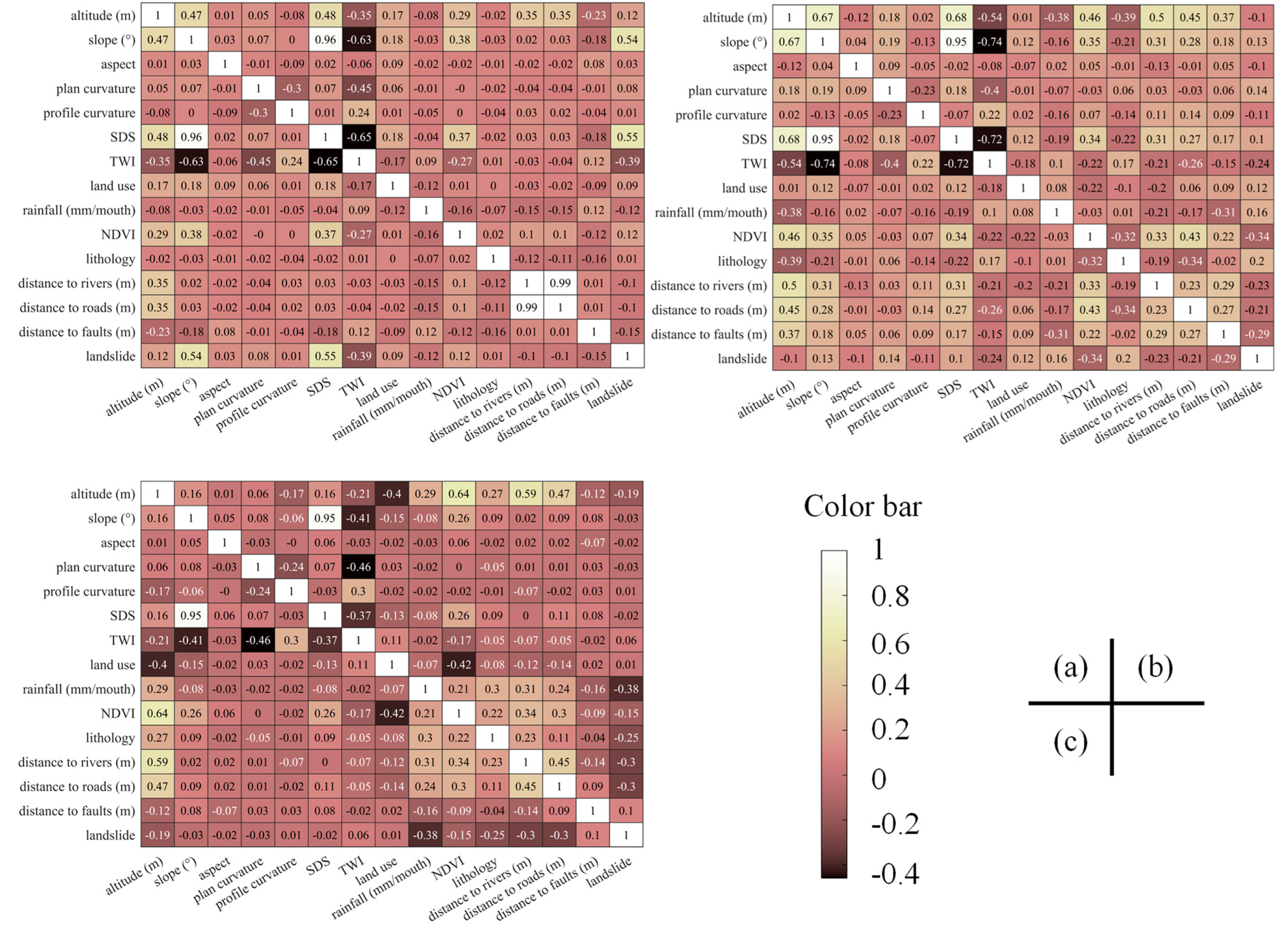
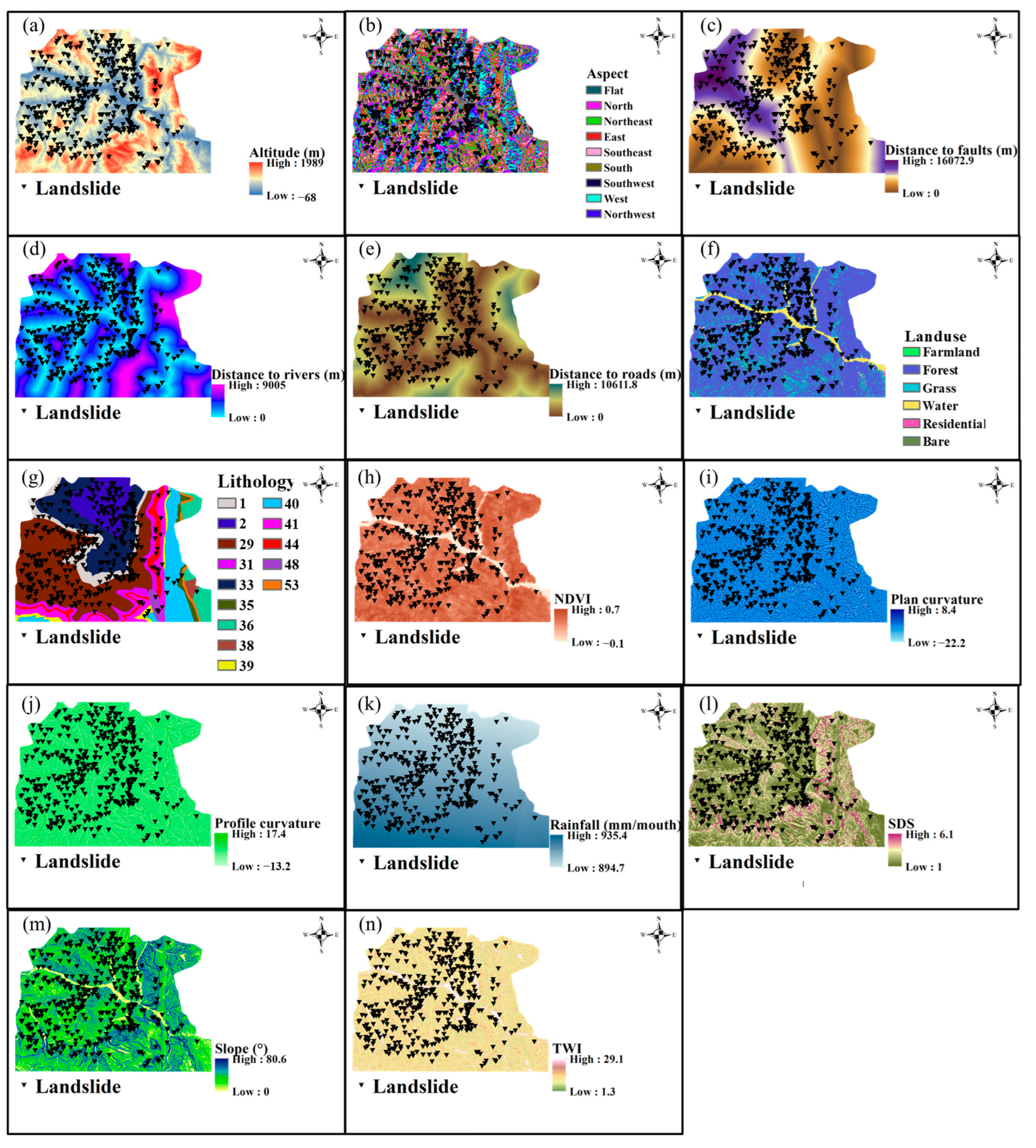
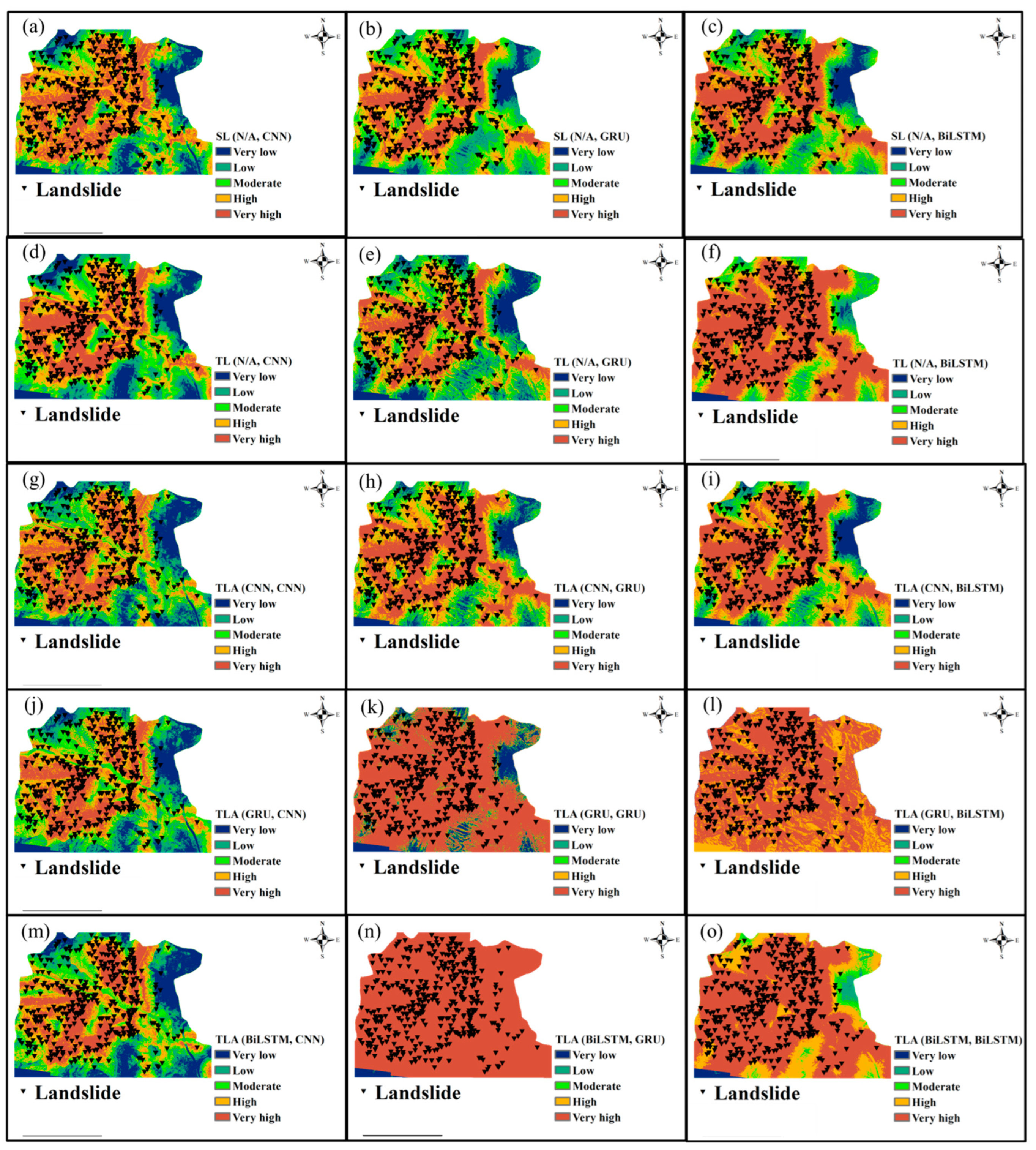
References
- Reichenbach, P.; Rossi, M.; Malamud, B.D.; Mihir, M.; Guzzetti, F. A review of statistically-based landslide susceptibility models. Earth-Sci. Rev. 2018, 180, 60–91. [Google Scholar] [CrossRef]
- Liu, Y.; Xu, C.; Huang, B.; Ren, X.W.; Liu, C.Q.; Hu, B.D.; Chen, Z. Landslide displacement prediction based on multi-source data fusion and sensitivity states. Eng. Geol. 2020, 271, 105608. [Google Scholar] [CrossRef]
- Wang, H.J.; Xiao, T.; Li, X.Y.; Zhang, L.L.; Zhang, L.M. A novel physically-based model for updating landslide susceptibility. Eng. Geol. 2019, 251, 71–80. [Google Scholar] [CrossRef]
- Park, J.Y.; Lee, S.R.; Lee, D.H.; Kim, Y.T.; Lee, J.S. A regional-scale landslide early warning methodology applying statistical and physically based approaches in sequence. Eng. Geol. 2019, 260, 105193. [Google Scholar] [CrossRef]
- Lin, S.; Zheng, H.; Han, B.; Li, Y.Y.; Han, C.; Li, W. Comparative performance of eight ensemble learning approaches for the development of models of slope stability prediction. Acta Geotech. 2022, 17, 1477–1502. [Google Scholar] [CrossRef]
- Lee, J.-H.; Sameen, M.I.; Pradhan, B.; Park, H.-J. Modeling landslide susceptibility in data-scarce environments using optimized data mining and statistical methods. Geomorphology 2018, 303, 284–298. [Google Scholar] [CrossRef]
- Chen, W.; Pourghasemi, H.R.; Naghibi, S.A. A comparative study of landslide susceptibility maps produced using support vector machine with different kernel functions and entropy data mining models in China. Bull. Eng. Geol. Environ. 2017, 77, 647–664. [Google Scholar] [CrossRef]
- Sun, D.L.; Wen, H.J.; Wang, D.Z.; Xu, J.H. A random forest model of landslide susceptibility mapping based on hyperparameter optimization using Bayes algorithm. Geomorphology 2020, 362, 107201. [Google Scholar]
- Wang, Y.; Fang, Z.; Hong, H. Comparison of convolutional neural networks for landslide susceptibility mapping in Yanshan County, China. Sci. Total Environ. 2019, 666, 975–993. [Google Scholar] [CrossRef]
- Krizhevsky, A.; Sutskever, I.; Hinton, G.E. ImageNet classification with deep convolutional neural networks. Commun. ACM 2017, 60, 84–90. [Google Scholar]
- Hakim, W.L.; Rezaie, F.; Nur, A.S.; Panahi, M.; Khosravi, K.; Lee, C.W.; Lee, S. Convolutional neural network (CNN) with metaheuristic optimization algorithms for landslide susceptibility mapping in Icheon, South Korea. J. Environ. Manag. 2022, 305, 114367. [Google Scholar] [CrossRef]
- He, Y.; Zhao, Z.A.; Yang, W.; Yan, H.W.; Wang, W.H.; Yao, S.; Zhang, L.F.; Liu, T. A unified network of information considering superimposed landslide factors sequence and pixel spatial neighbourhood for landslide susceptibility mapping. Int. J. Appl. Earth Obs. Geoinf. 2021, 104, 102508. [Google Scholar] [CrossRef]
- Wang, H.J.; Zhang, L.M.; Luo, H.Y.; He, J.; Cheung, R.W.M. AI-powered landslide susceptibility assessment in Hong Kong. Eng. Geol. 2021, 288, 106103. [Google Scholar] [CrossRef]
- Yi, Y.N.; Zhang, Z.J.; Zhang, W.C.; Jia, H.H.; Zhang, J.Q. Landslide susceptibility mapping using multiscale sampling strategy and convolutional neural network: A case study in Jiuzhaigou region. Catena 2020, 195, 104851. [Google Scholar] [CrossRef]
- Yang, Y.; Yang, J.T.; Xu, C.D.; Xu, C.; Song, C. Local-scale landslide susceptibility mapping using the B-GeoSVC model. Landslides 2019, 16, 1301–1312. [Google Scholar] [CrossRef]
- Zhu, Q.; Chen, L.; Hu, H.; Pirasteh, S.; Li, H.F.; Xie, X. Unsupervised Feature Learning to Improve Transferability of Landslide Susceptibility Representations. IEEE J. Sel. Top. Appl. Earth Obs. Remote Sens. 2020, 13, 3917–3930. [Google Scholar] [CrossRef]
- Al-Najjar, H.A.H.; Pradhan, B. Spatial landslide susceptibility assessment using machine learning techniques assisted by additional data created with generative adversarial networks. Geosci. Front. 2021, 12, 625–637. [Google Scholar] [CrossRef]
- Lei, H.J.; Han, T.; Zhou, F.; Yu, Z.; Qin, J.; Elazab, A.; Lei, B.Y. A deeply supervised residual network for HEp-2 cell classification via cross-modal transfer learning. Pattern Recognit. 2018, 79, 290–302. [Google Scholar] [CrossRef]
- Zhuang, F.Z.; Duan, K.Y.; Xi, D.B.; Zhu, Y.C.; Zhu, H.S.; Xiong, H.; He, Q. A Comprehensive Survey on Transfer Learning. Proc. IEEE 2021, 109, 43–76. [Google Scholar] [CrossRef]
- Deng, W.J.; Zheng, L.; Ye, Q.X.; Kang, G.L.; Yang, Y.; Jiao, J.B. Image-Image Domain Adaptation with Preserved Self-Similarity and Domain-Dissimilarity for Person Re-identification. arXiv 2017, arXiv:1512.09300v2. [Google Scholar]
- Larsen, A.B.L.; Sønderby, S.K.; Larochelle, H.; Winther, O. Autoencoding beyond pixels using a learned similarity metric. arXiv 2016, arXiv:1711.07027v3. [Google Scholar]
- Tian, Y.Y.; Xu, C.; Ma, S.Y.; Xu, X.W.; Wang, S.Y.; Zhang, H. Inventory and Spatial Distribution of Landslides Triggered by the 8th August 2017 MW 6.5 Jiuzhaigou Earthquake, China. J. Earth Sci. 2018, 30, 206–217. [Google Scholar] [CrossRef]
- Li, Y.; Yang, X.D.; Fang, H.; Yin, C.R.; Qu, X.Y. Zoning Atlas of Geological Disaster Susceptibility Levels in Typical Counties (Cities) in China; Science Press: Beijing, China, 2012. [Google Scholar]
- Ayalew, L.; Yamagishi, H. The application of GIS-based logistic regression for landslide susceptibility mapping in the Kakuda-Yahiko Mountains, Central Japan. Geomorphology 2005, 65, 15–31. [Google Scholar] [CrossRef]
- Huang, F.M.; Cao, Z.S.; Guo, J.F.; Jiang, S.H.; Li, S.; Guo, Z.Z. Comparisons of heuristic, general statistical and machine learning models for landslide susceptibility prediction and mapping. Catena 2020, 191, 104580. [Google Scholar] [CrossRef]
- Aditian, A.; Kubota, T.; Shinohara, Y. Comparison of GIS-based landslide susceptibility models using frequency ratio, logistic regression, and artificial neural network in a tertiary region of Ambon, Indonesia. Geomorphology 2018, 318, 101–111. [Google Scholar] [CrossRef]
- Chang, Z.L.; Du, Z.; Zhang, F.; Huang, F.M.; Chen, J.W.; Li, W.B.; Guo, Z.Z. Landslide Susceptibility Prediction Based on Remote Sensing Images and GIS: Comparisons of Supervised and Unsupervised Machine Learning Models. Remote Sens. 2020, 12, 502. [Google Scholar] [CrossRef]
- Lin, M.S.; Teng, S.; Chen, G.F.; Hu, B. Application of convolutional neural networks based on Bayesian optimization to landslide susceptibility mapping of transmission tower foundation. Bull. Eng. Geol. Environ. 2023, 82, 51. [Google Scholar] [CrossRef]
- Guo, Z.Z.; Shi, Y.; Huang, F.M.; Fan, X.M.; Huang, J.S. Landslide susceptibility zonation method based on C5.0 decision tree and K-means cluster algorithms to improve the efficiency of risk management. Geosci. Front. 2021, 12, 101249. [Google Scholar] [CrossRef]
- Pham, B.T.; Bui, D.T.; Indra, P.; Dholakia, M.B. Landslide Susceptibility Assessment at a Part of Uttarakhand Himalaya, India using GIS-based Statistical Approach of Frequency Ratio Method. Int. J. Eng. Res. Technol. 2015, 4, 338–344. [Google Scholar]
- Oh, H.J.; Pradhan, B. Application of a neuro-fuzzy model to landslide-susceptibility mapping for shallow landslides in a tropical hilly area. Comput. Geosci. 2011, 37, 1264–1276. [Google Scholar] [CrossRef]
- Wu, Y.L.; Ke, Y.T.; Chen, Z.; Liang, S.Y.; Zhao, H.L.; Hong, H.Y. Application of alternating decision tree with AdaBoost and bagging ensembles for landslide susceptibility mapping. Catena 2020, 187, 104396. [Google Scholar] [CrossRef]
- Atkinson, P.M.; Massari, R. Generalised linear modelling of susceptibility to landsliding in the central apennines, Italy. Comput. Geosci. 1998, 24, 373–385. [Google Scholar] [CrossRef]
- Moore, I.D.; Grayson, R.B.; Ladson, A.R. Digital terrain modelling: A review of hydrological, geomorphological, and biological applications. Hydrol. Process. 1991, 5, 3–30. [Google Scholar] [CrossRef]
- Pham, B.T.; Bui, D.T.; Prakash, I.; Dholakia, M.B. Rotation forest fuzzy rule-based classifier ensemble for spatial prediction of landslides using GIS. Nat. Hazards 2016, 83, 97–127. [Google Scholar] [CrossRef]
- Gong, P.; Liu, H.; Zhang, M.N.; Li, C.C.; Wang, J.; Huang, H.B.; Clinton, N.; Ji, L.Y.; Li, W.Y.; Bai, Y.Q.; et al. Stable classification with limited sample: Transferring a 30-m resolution sample set collected in 2015 to mapping 10-m resolution global land cover in 2017. Sci. Bull. 2019, 64, 370–373. [Google Scholar] [CrossRef]
- Pham, B.T.; Bui, D.T.; Dholakia, M.B.; Prakash, I.; Pham, H.V. A Comparative Study of Least Square Support Vector Machines and Multiclass Alternating Decision Trees for Spatial Prediction of Rainfall-Induced Landslides in a Tropical Cyclones Area. Geotech. Geol. Eng. 2016, 34, 1807–1824. [Google Scholar] [CrossRef]
- Bui, D.T.; Hoang, N.D. A Bayesian framework based on a Gaussian mixture model and radial-basis-function Fisher discriminant analysis (BayGmmKda V1.1) for spatial prediction of floods. Geosci. Model Dev. 2017, 10, 3391–3409. [Google Scholar]
- Arabameri, A.; Chen, W.; Loche, M.; Zhao, X.; Li, Y.; Lombardo, L.; Cerda, A.; Pradhan, B.; Bui, D.T. Comparison of machine learning models for gully erosion susceptibility mapping. Geosci. Front. 2020, 11, 1609–1620. [Google Scholar] [CrossRef]
- Dwyer, J.; Schmidt, G. The MODIS Reprojection Tool. In Earth Science Satellite Remote Sensing; Qu, J.J., Gao, W., Kafatos, M., Murphy, R.E., Salomonson, V.V., Eds.; Springer: Berlin/Heidelberg, Germany, 2006. [Google Scholar]
- Li, C.Y.; Wang, X.C.; He, C.Z.; Wu, X.; Kong, Z.Y.; Li, X.L. National 1:200,000 Digital Geological Map (Public Edition) Spatial Database. Geol. China 2019, 46, 1–10. [Google Scholar]
- Asadi, M.; Mokhtari, L.G.; Shirzadi, A.; Shahabi, H.; Bahrami, S. A comparison study on the quantitative statistical methods for spatial prediction of shallow landslides (case study: Yozidar-Degaga Route in Kurdistan Province, Iran). Environ. Earth Sci. 2022, 81, 51. [Google Scholar] [CrossRef]
- Xing, Y.; Yue, J.P.; Guo, Z.Z.; Chen, Y.; Hu, J.; Travé, A. Large-Scale Landslide Susceptibility Mapping Using an Integrated Machine Learning Model: A Case Study in the Lvliang Mountains of China. Front. Earth Sci. 2021, 9, 722491. [Google Scholar] [CrossRef]
- Nhu, V.H.; Mohammadi, A.; Shahabi, H.; Ahmad, B.B.; Al-Ansari, N.; Shirzadi, A.; Geertsema, M.R.; Kress, V.; Karimzadeh, S.; Valizadeh Kamran, K.; et al. Landslide Detection and Susceptibility Modeling on Cameron Highlands (Malaysia): A Comparison between Random Forest, Logistic Regression and Logistic Model Tree Algorithms. Forests 2020, 11, 830. [Google Scholar] [CrossRef]
- Zhou, Q.Q.; Si-Tu, Z.X.; Teng, S.; Chen, G.F. Convolutional Neural Networks–Based Model for Automated Sewer Defects Detection and Classification. J. Water Resour. Plan. Manag. 2021, 147, 04021036. [Google Scholar] [CrossRef]
- Dash, M.; Liu, H. Feature Selection for Classification. Intell. Data Anal. 1997, 1, 131–156. [Google Scholar] [CrossRef]
- Lin, M.S.; Teng, S.; Chen, G.F.; Lv, J.B.; Hao, Z.Y. Optimal CNN-based semantic segmentation model of cutting slope images. Front. Struct. Civ. Eng. 2022, 16, 414–433. [Google Scholar] [CrossRef]
- Thi-Ngo, P.T.; Panahi, M.; Khosravi, K.; Ghorbanzadeh, O.; Kariminejad, N.; Cerda, A.; Lee, S. Evaluation of deep learning algorithms for national scale landslide susceptibility mapping of Iran. Geosci. Front. 2021, 12, 505–519. [Google Scholar] [CrossRef]
- Garrido-Merchán, E.C.; Hernández-Lobato, D. Dealing with categorical and integer-valued variables in Bayesian Optimization with Gaussian processes. Neurocomputing 2020, 380, 20–35. [Google Scholar] [CrossRef]
- Yuan, R.; Chen, J. A hybrid deep learning method for landslide susceptibility analysis with the application of InSAR data. Nat. Hazards 2022, 114, 1393–1426. [Google Scholar] [CrossRef]
- Wang, Z.; Goetz, J.; Brenning, A. Transfer learning for landslide susceptibility modeling using domain adaptation and case-based reasoning. Geosci. Model Dev. 2022, 15, 8765–8784. [Google Scholar] [CrossRef]
- Lin, Q.; Ci, T.; Wang, L.; Mondal, S.K.; Yin, H.; Wang, Y. Transfer Learning for Improving Seismic Building Damage Assessment. Remote Sens. 2022, 14, 201. [Google Scholar] [CrossRef]
- Zhao, G.; Pang, B.; Xu, Z.; Cui, L.; Wang, J.; Zuo, D.; Peng, D. Improving urban flood susceptibility mapping using transfer learning. J. Hydrol. 2021, 602, 126777. [Google Scholar] [CrossRef]
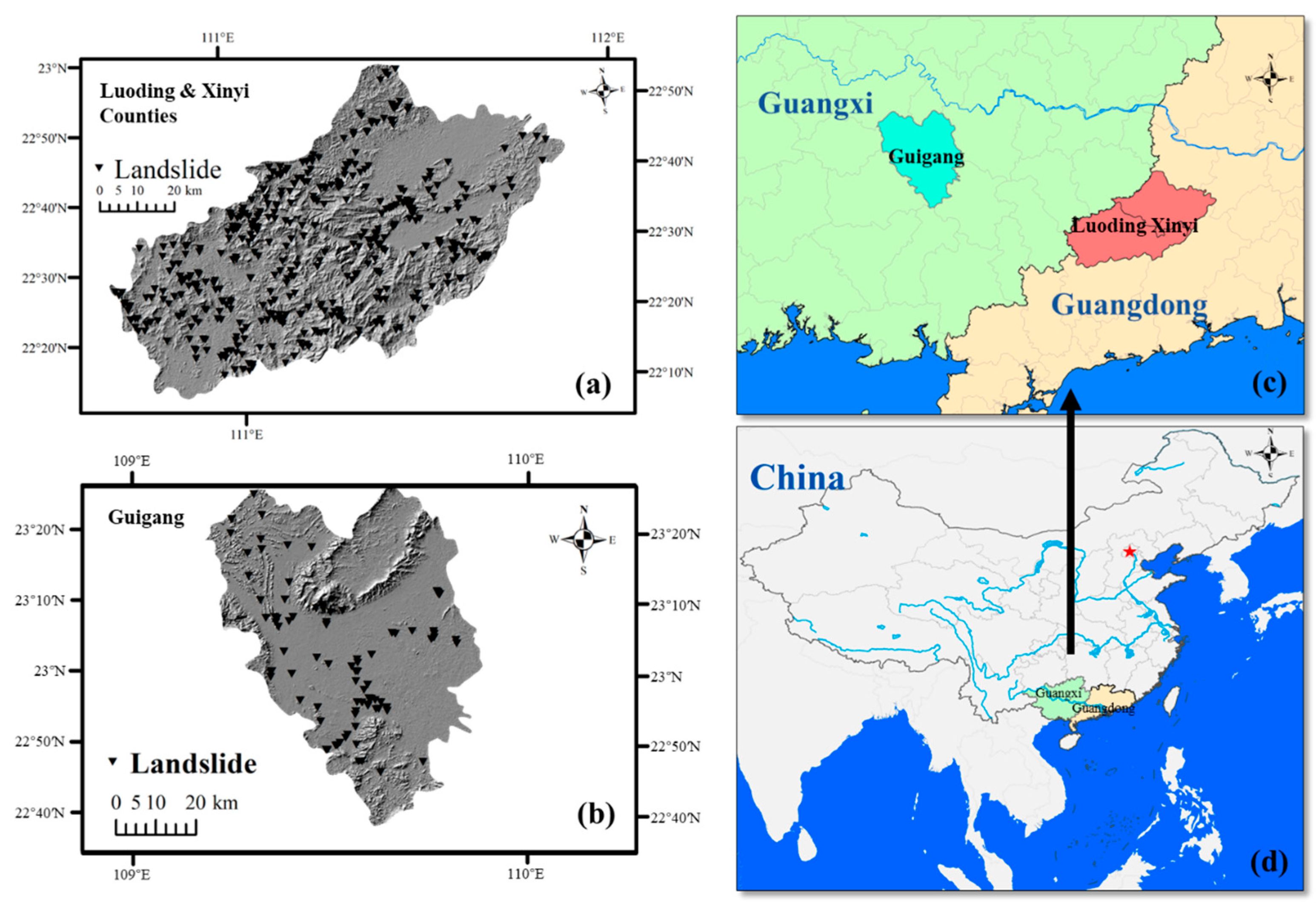
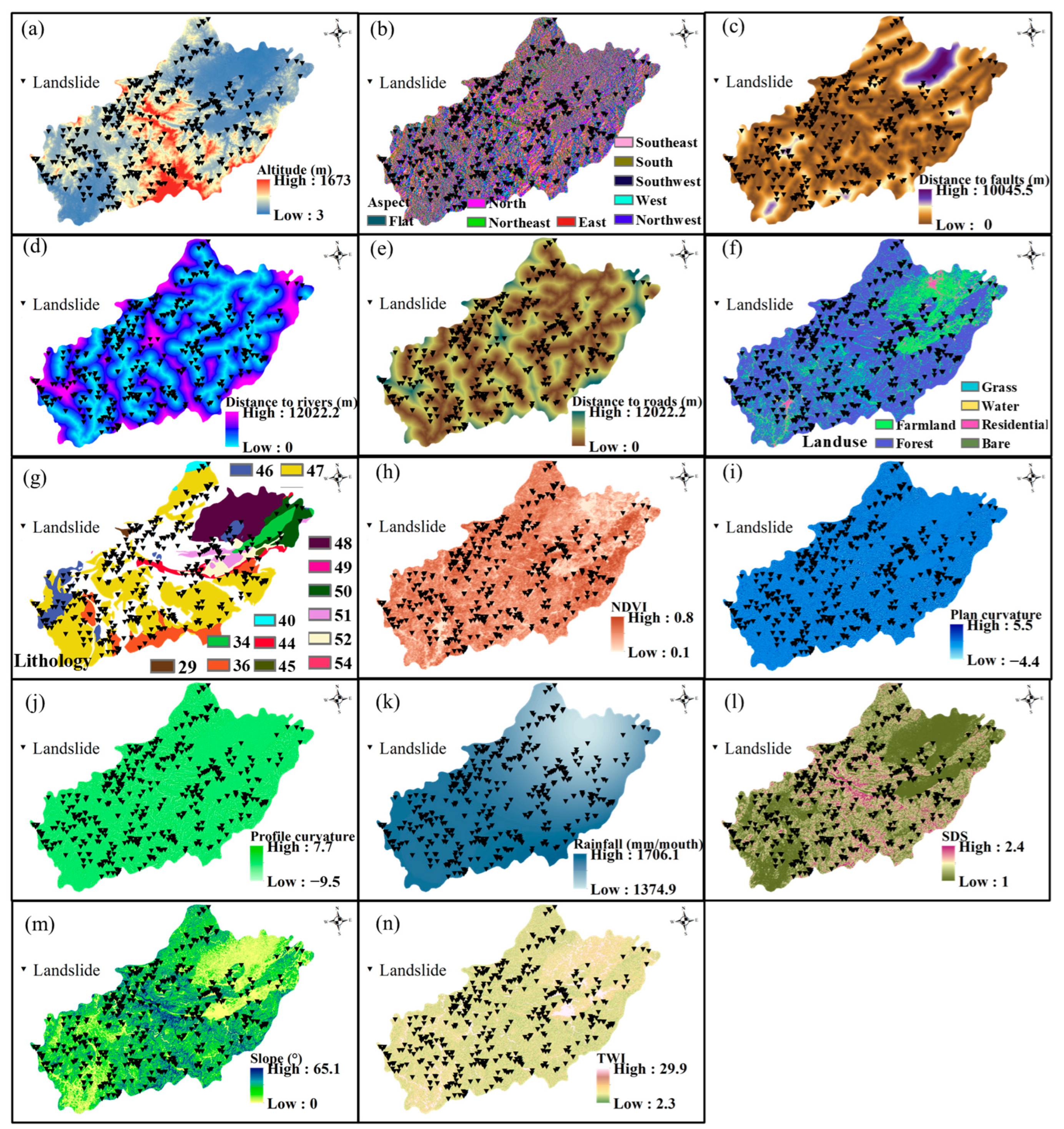



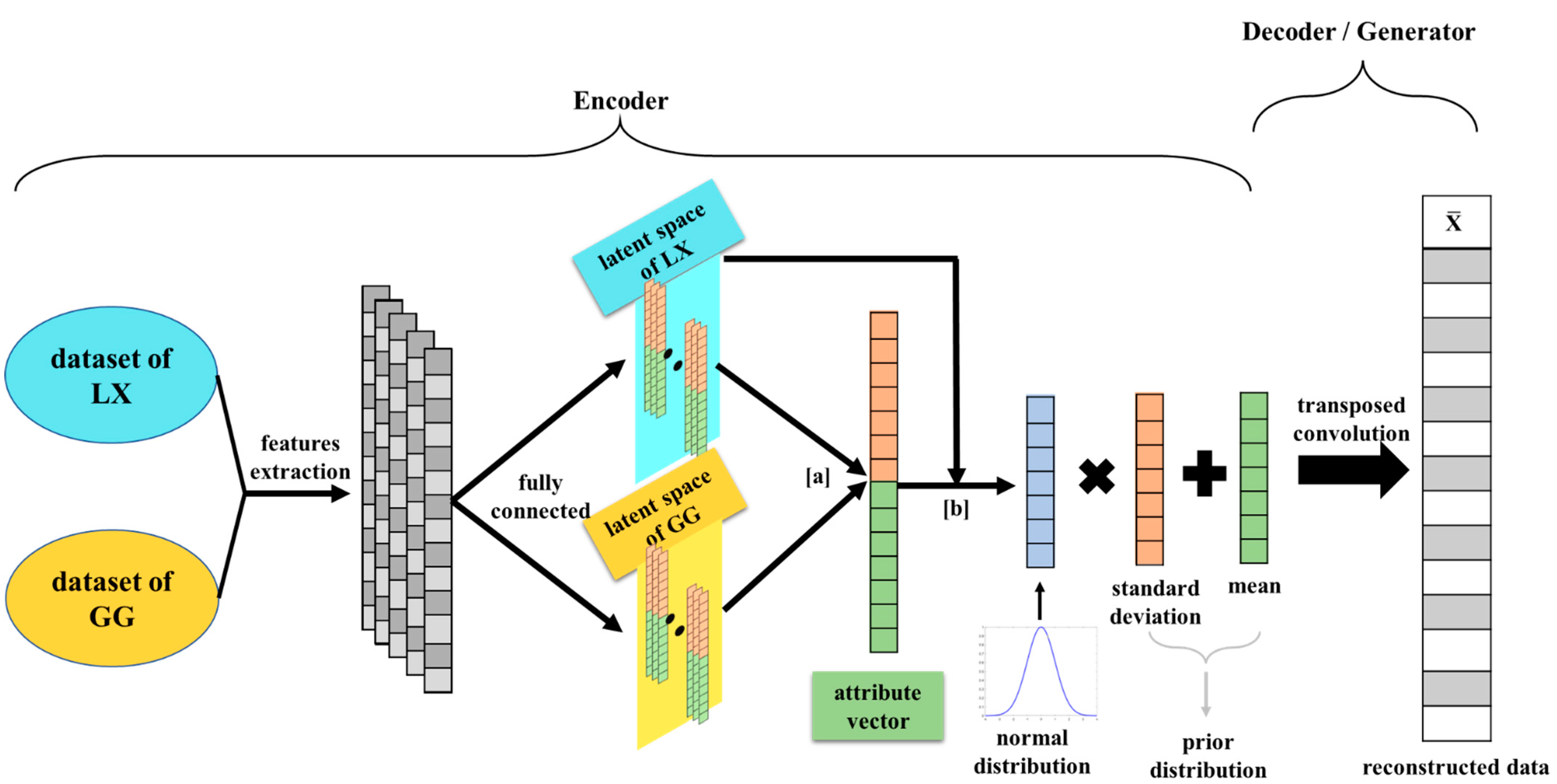
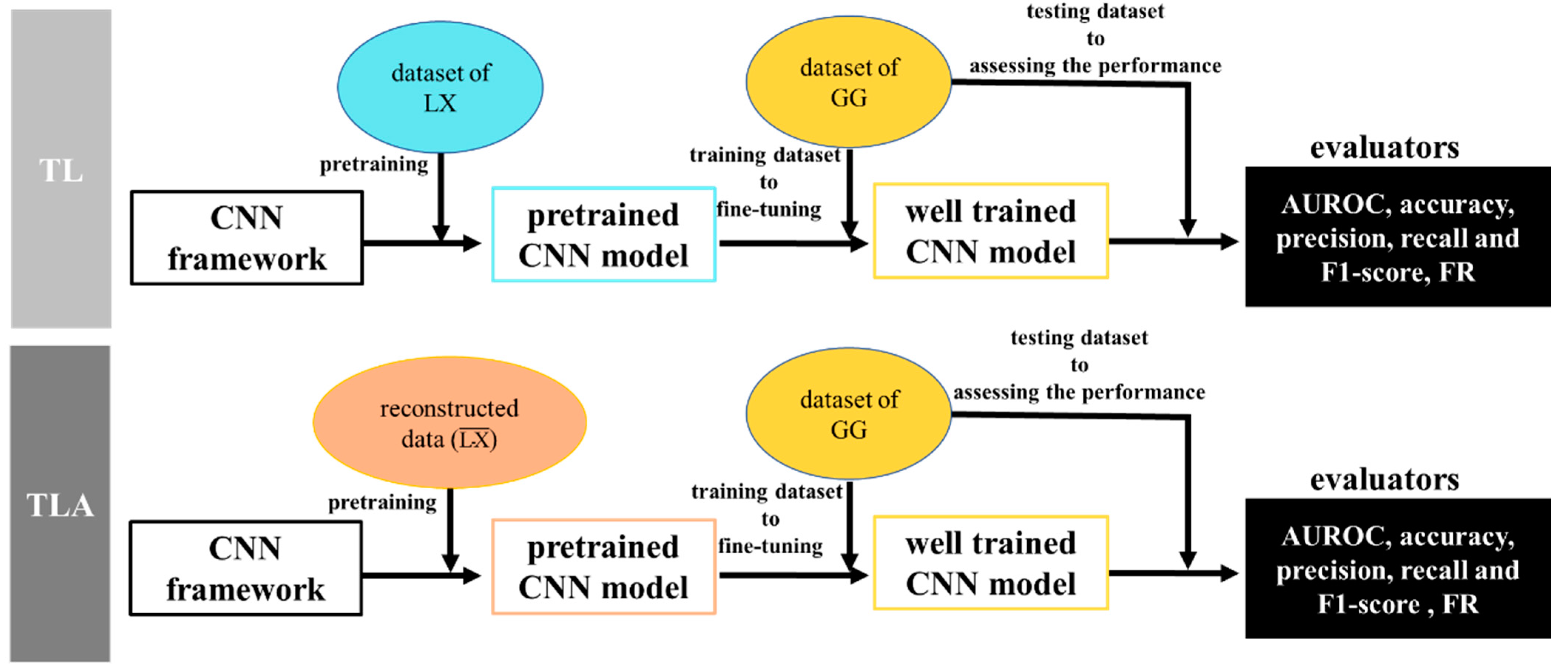

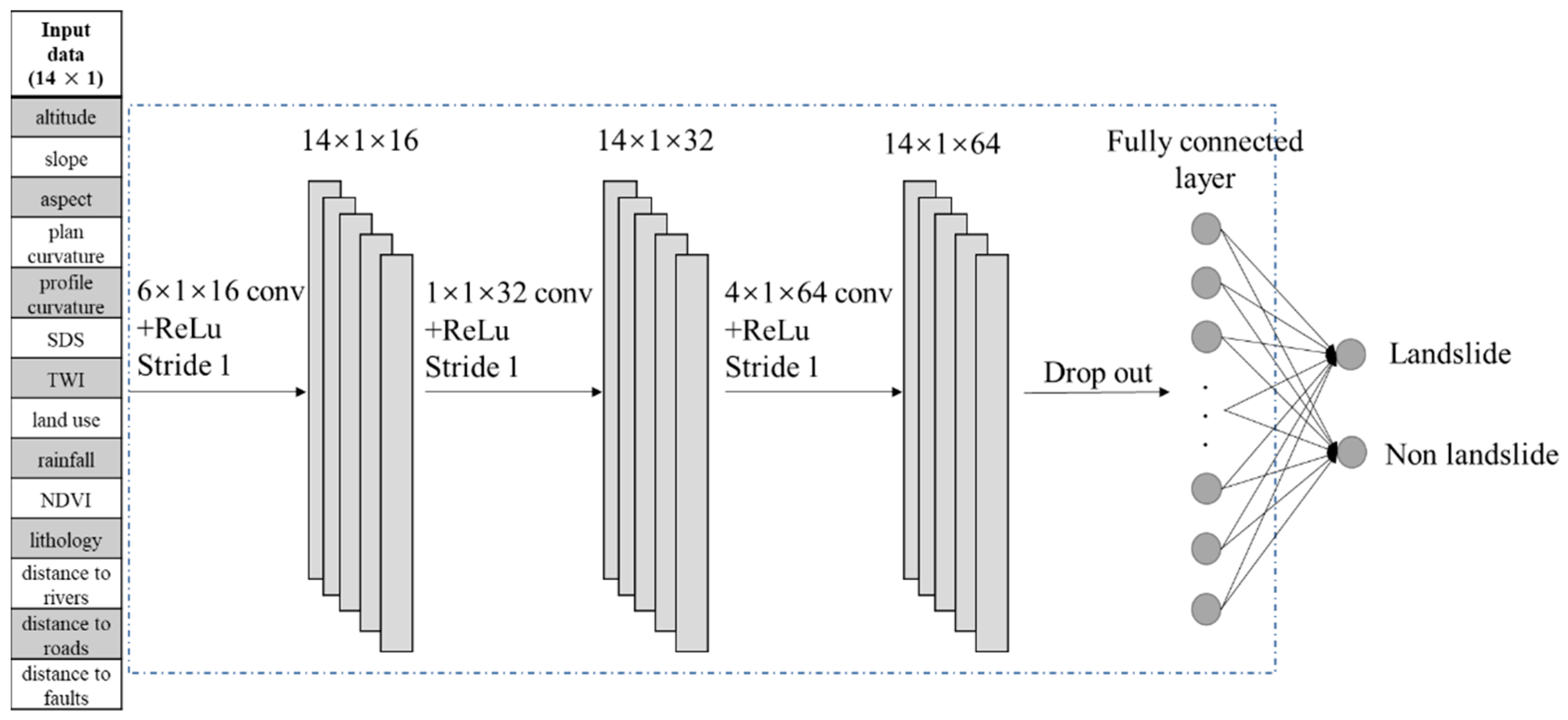
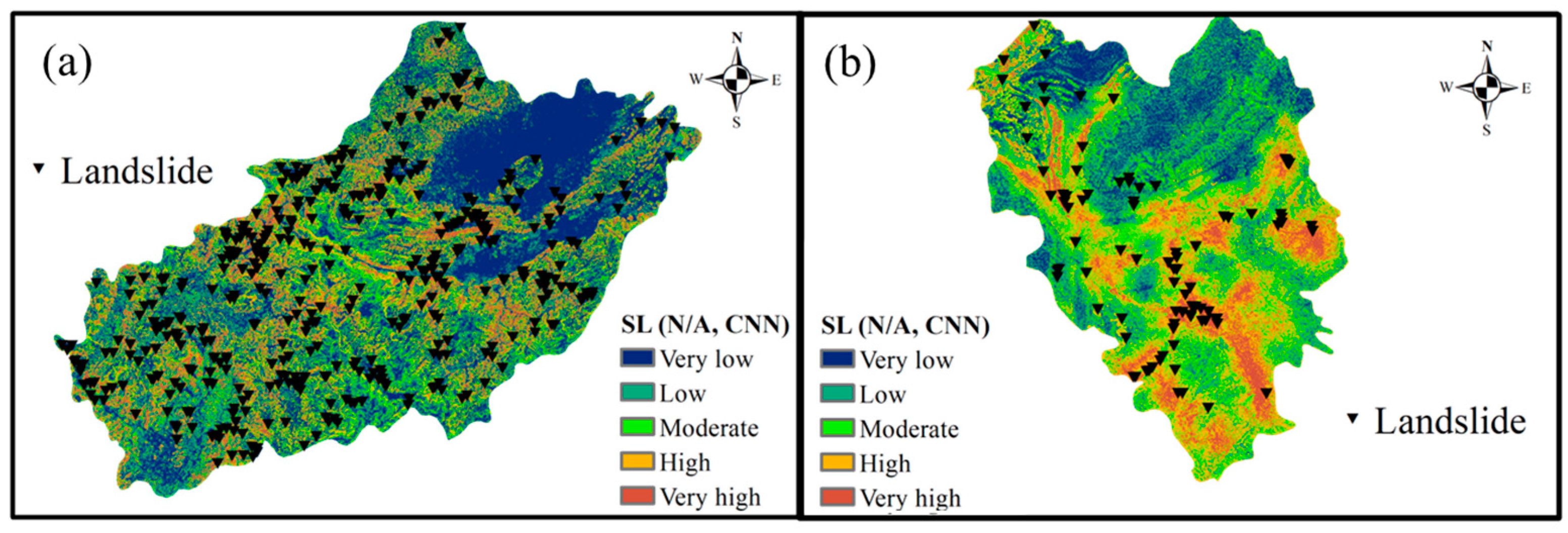
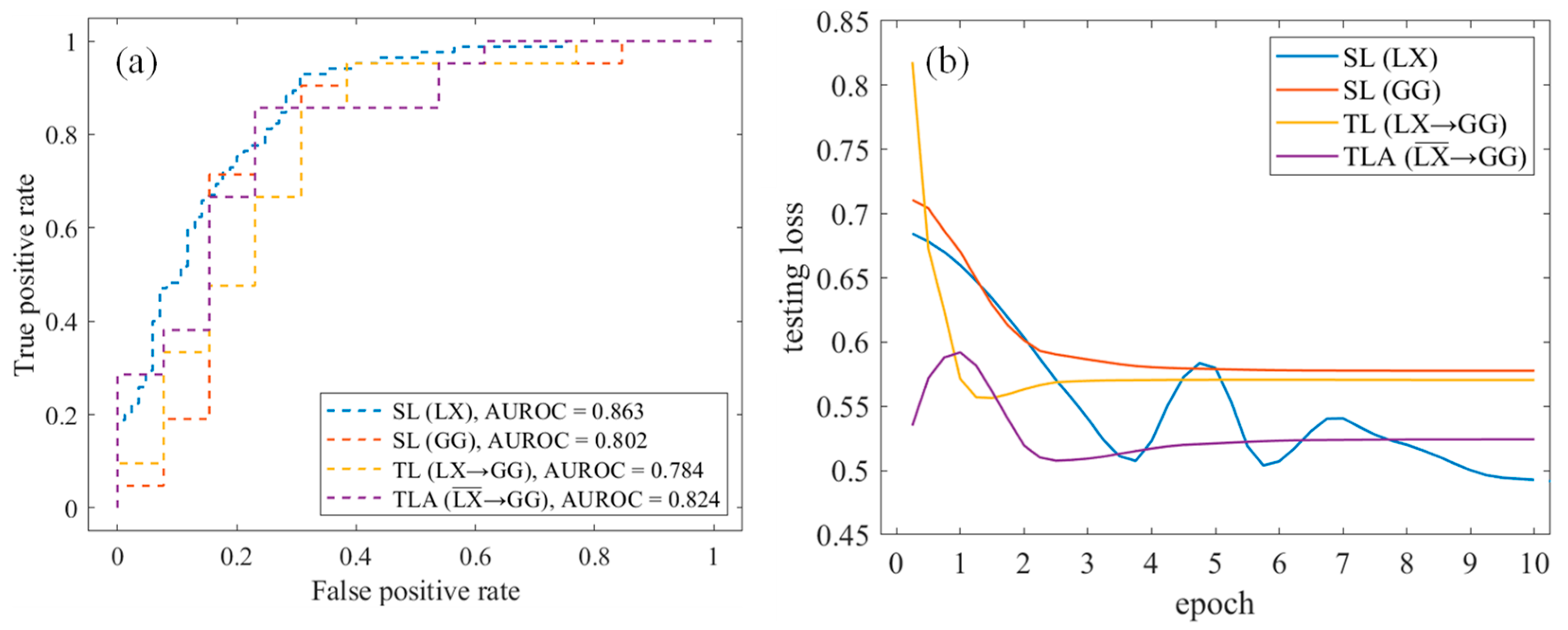




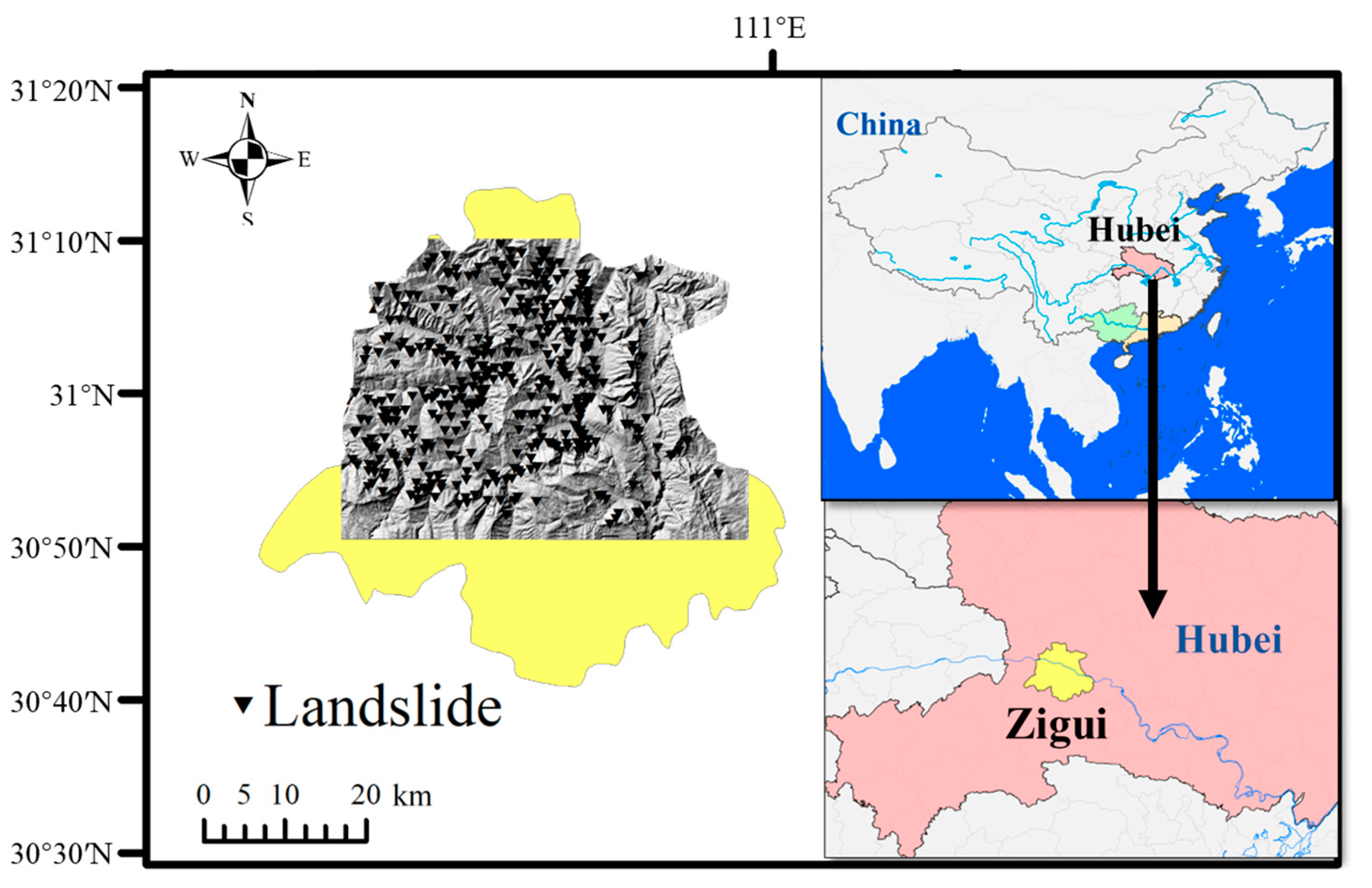





| # | Category | Factors | Reason for Selection | Data Source |
|---|---|---|---|---|
| 1 | Topography | Altitude | Slope is closely related to the local altitude, so altitude is one of the factors that influence landslides [29]. | The digital elevation model (DEM) with a 30 m resolution of the study area can be downloaded from http://www.gscloud.cn/home (accessed on 23 June 2022). |
| 2 | Slope angle | This directly affects slope stability and has been widely used in landslide sensitivity analysis [9]. | DEM derivatives. | |
| 3 | Aspect | This is related to the landslides in that slopes in different orientations are differently affected by precipitation and solar radiation [30]. | DEM derivatives. | |
| 4 | Plan curvature | This reflects the rate of change of the aspect along the contour and thus can affect the flow of water across a surface [31]. | DEM derivatives. | |
| 5 | Profile curvature | This influences the acceleration and deceleration of flow through slope; thus, some valuable information about erosion and deposition is provided [32]. | DEM derivatives. | |
| 6 | SDS | This is an index reflecting the degree of surface fluctuation and erosion intensity [33]. | . | |
| 7 | TWI | TWI describes the topographic properties of hydrological processes in that both slope and local upslope contribution areas are considered [34]. | , where SCA is the specific catchment area ( and is the slope angle (degree) of the position. | |
| 8 | Environmental | Land use | Land use is a key factor in landslides and has an important influence on the stability of slopes thanks to vegetation cover [35]. | Land-use data are from a study in 2015 [36]. |
| 9 | Rainfall | This is a key landslide-inducing factor in that it can affect the shear strength of the slope [37]. | The rainfall (mm/month) raster data in the study area were obtained by using the inverse-distance weighting interpolation method [38] on rain stations (http://data.cma.cn/, accessed on 5 January 2022) in the vicinity of the study area. | |
| 10 | NDVI | This reflects the greenness of an area and may alter the distribution of soil and hydrological processes on slopes [39]. | The NDVI data were obtained from the MOD13Q1 product, which were downloaded from https://search.earthdata.nasa.gov/search (accessed on 3 July 2022) and processed by the MODIS projection tool [40]. Furthermore, in order to minimize potential atmospheric effects, the NDVI data used in the paper are the average value of the entire year of 2015. | |
| 11 | Distance to rivers | Rivers affect slope stability in that they can cut and erode banks, and these actions reshape and sculpt the landscape. In addition, fluctuations in the water level greatly affect the groundwater level of the slope [29]. | The data come from the National Geomatics Center of China (http://www.ngcc.cn/ngcc/ (accessed on 20 May 2022), and the Euclidean distance tool of ArcGIS is used to obtain the river distance in the study area. | |
| 12 | Distance to roads | This is considered to be one of the most important human factors affecting the occurrence of landslides [7]. | The method of obtaining the road distance raster data is the same that for obtaining the river distance. | |
| 13 | Geological | Lithology | The mechanical and hydrological properties of rock masses (such as permeability and friction angle) differ between lithological units, so this factor can greatly affect slope stability [37]. | Geological maps of the study area were obtained from the National 1:200,000 Digital Geological Map (Public Edition) of China [41]. The description of the lithological formations in the study areas are shown in Table A2 of Appendix A. |
| 14 | Distance to faults | This has an important influence on the distribution and scale of landslides in the study area [30]. | The data on the locations of faults in the study area were obtained from the National 1:200,000 Digital Geological Map (Public Edition) Spatial Database of China [41], and The Euclidean distance tool of ArcGIS was used to obtain the fault distance in the study area. |
| Group | Parameters | Search Space | Best Value |
|---|---|---|---|
| CNN architecture | Convolution kernel number | [1, 5] | 3 |
| Max pool layer number | [0, 5] | 0 | |
| CNN hyperparameters | Convolution kernel size | [1, 6] | 6, 1, 4 |
| Convolution kernel channel | [8, 16] | 16, 32, 64 | |
| Max pool size | [0, 5] | 0 | |
| Dropout rate | [0.1, 0.7] | 0.2249 | |
| Training options | Initial learning rate | [0.001, 1] | 0.0059 |
| Learn rate schedule | piecewise decay, constant | piecewise decay | |
| Learn rate drop period | [1, 10] | 2 | |
| Learn rate drop factor | [0.1 0.9] | 0.1462 | |
| minibatch size | [6, 30] | 30 |
| Study Area | Model | Evaluators | |||||
|---|---|---|---|---|---|---|---|
| AUROC | Accuracy | Precision | Recall | F1-Score | Mean | ||
| LX | CNN | 0.863 | 0.771 | 0.788 | 0.761 | 0.775 | 0.792 |
| GG | 0.802 | 0.735 | 0.833 | 0.714 | 0.769 | 0.771 | |
| Training | Testing | Experiment | Model |
|---|---|---|---|
| CNN | |||
| LX | LX | A (SL) | 0.771 |
| LX & GG | GG | B (TL) | 0.772 |
| & GG | C (CNN-VAEGAN) | 0.844 |
| Study Area | Model | Evaluators | |||||
|---|---|---|---|---|---|---|---|
| AUROC | Accuracy | Precision | Recall | F1-Score | Mean | ||
| LX | CNN | 0.863 | 0.771 | 0.788 | 0.761 | 0.775 | 0.792 |
| GRU | 0.836 | 0.771 | 0.756 | 0.694 | 0.724 | 0.756 | |
| BiLSTM | 0.832 | 0.753 | 0.709 | 0.859 | 0.777 | 0.786 | |
| GG | CNN | 0.802 | 0.735 | 0.833 | 0.714 | 0.769 | 0.771 |
| GRU | 0.784 | 0.559 | 0.800 | 0.381 | 0.516 | 0.608 | |
| BiLSTM | 0.714 | 0.706 | 0.739 | 0.810 | 0.773 | 0.748 | |
| Training | Testing | Experiment | Models | ||
|---|---|---|---|---|---|
| CNN | GRU | BiLSTM | |||
| GG | GG | A (SL) | 0.771 | 0.608 | 0.748 |
| LX & GG | B (TL) | 0.772 | 0.710 | 0.770 | |
| & GG | C (CNN-VAEGAN) | 0.844 | 0.698 | 0.767 | |
| & GG | D (GRU-VAEGAN) | 0.783 | 0.689 | 0.746 | |
| & GG | E (BiLSTM-VAEGAN) | 0.793 | 0.708 | 0.783 | |
| Study Area | Model | Evaluators | |||||
|---|---|---|---|---|---|---|---|
| AUROC | Accuracy | Precision | Recall | F1-Score | Mean | ||
| ZG | CNN | 0.800 | 0.747 | 0.704 | 0.852 | 0.771 | 0.775 |
| GRU | 0.729 | 0.691 | 0.663 | 0.777 | 0.716 | 0.715 | |
| BiLSTM | 0.754 | 0.710 | 0.689 | 0.765 | 0.725 | 0.729 | |
| Training | Testing | Experiment | Models | ||
|---|---|---|---|---|---|
| CNN | GRU | BiLSTM | |||
| ZG | ZG | A (Supervised Learning) | 0.775 | 0.715 | 0.729 |
| LX & ZG | B (TL) | 0.753 | 0.716 | 0.734 | |
| & ZG | C (CNN-VAEGAN) | 0.818 | 0.730 | 0.731 | |
| & ZG | D (GRU-VAEGAN) | 0.794 | 0.708 | 0.674 | |
| & ZG | E (BiLSTM-VAEGAN) | 0.804 | 0.735 | 0.741 | |
Disclaimer/Publisher’s Note: The statements, opinions and data contained in all publications are solely those of the individual author(s) and contributor(s) and not of MDPI and/or the editor(s). MDPI and/or the editor(s) disclaim responsibility for any injury to people or property resulting from any ideas, methods, instructions or products referred to in the content. |
© 2023 by the authors. Licensee MDPI, Basel, Switzerland. This article is an open access article distributed under the terms and conditions of the Creative Commons Attribution (CC BY) license (https://creativecommons.org/licenses/by/4.0/).
Share and Cite
Lin, M.; Teng, S.; Chen, G.; Bassir, D. Transfer Learning with Attributes for Improving the Landslide Spatial Prediction Performance in Sample-Scarce Area Based on Variational Autoencoder Generative Adversarial Network. Land 2023, 12, 525. https://doi.org/10.3390/land12030525
Lin M, Teng S, Chen G, Bassir D. Transfer Learning with Attributes for Improving the Landslide Spatial Prediction Performance in Sample-Scarce Area Based on Variational Autoencoder Generative Adversarial Network. Land. 2023; 12(3):525. https://doi.org/10.3390/land12030525
Chicago/Turabian StyleLin, Mansheng, Shuai Teng, Gongfa Chen, and David Bassir. 2023. "Transfer Learning with Attributes for Improving the Landslide Spatial Prediction Performance in Sample-Scarce Area Based on Variational Autoencoder Generative Adversarial Network" Land 12, no. 3: 525. https://doi.org/10.3390/land12030525
APA StyleLin, M., Teng, S., Chen, G., & Bassir, D. (2023). Transfer Learning with Attributes for Improving the Landslide Spatial Prediction Performance in Sample-Scarce Area Based on Variational Autoencoder Generative Adversarial Network. Land, 12(3), 525. https://doi.org/10.3390/land12030525








